생후 12∼15개월 유아들의 성장 발육, Growth and development of 12~15 month old toddlers
표 3-20. 12개월 된 한국 유아들의 체중과 신장의 백분위수
|
백분위 수
성별 |
3 | 10 | 25 | 50 | 75 | 90 | 97 | |
| 남아 | 체중(kg) | 7.35 | 8.10 | 8.70 | 9.45 | 10.12 | 11.00 | 12.40 |
| 남아신장(cm) | 68.0 | 70.7 | 73.2 | 75.5 | 78.1 | 82.0 | 87.0 | |
| 여아 | 체중(kg) | 7.10 | 7.70 | 8.20 | 9.00 | 9.69 | 10.48 | 12.37 |
| 여아신장(cm) | 67.3 | 70.1 | 72.5 | 74.7 | 77.0 | 79.0 | 81.0 |
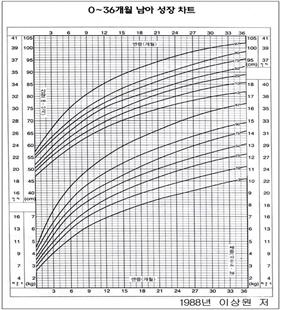
그림 3-118. 생후 0~36개월 된 한국 남 신생아들과 남 영유아들의 성장차트와 백분위수.
Copyright ⓒ 2012 John Sangwon Lee, MD., FAAP

그림 3-119. 생후 0~36개월 된 한국 여 신생아
들과 여 영유아들의 성장차트와 백분위수.
Copyright ⓒ 2012 John Sangwon Lee, MD., FAAP
- 생후 12개월부터 초등학교에 입학할 때까지 유아들, 즉 1~6세 아이들을 유아(幼兒)들이라고 한다.
- 1~6세의 기간을 유아기라 한다.
- 1~3세 유아들을 타들러(Toddlers)라고도 하고 1, 2, 3세의 기간을 유아 전기라고도 하고 4, 5, 6세의 기간을 학령기전 유아기라고 한다.
- 미국에서는 타들어(토들러/Toddler)란 말을 많이 쓰는데 여기서는 1, 2, 3세 유아들을 의미한다.
- 이 나이의 유아의 체중치와 신장치를 재어 성장차트 체중·신장 백분위선에 그려 본다.
- 그 다음 성장차트 백분위선 상 어디에 있는지 확인한다.
- 그 유아의 체중과 신장이 성장차트 체중·신장 백분위선을 따라 전과 거의 같게 계속 증가하면서 정상적으로 잘 자라는지 알아본다.
- 1세 된 유아의 몸무게는 출생 시 몸무게의 세 배가 되는 것이 보통이다. 돌 이후 유치원에 들어가기 전까지의 유아들은 그 전보다 육체적으로 상당히 활동적이고 그들 자신들이 가지고 있는 것들 이외 다른 사람들이 가지고 있는 것들과 주위에 있는 모든 것들에 상당히 많은 관심을 갖고 흥미를 갖는 것이 보통이다.
- 장난치면서 놀기를 좋아하고 한 곳에 가만히 있으려 하지 않는 것이 보통이다.
- 1세 이전 영아들의 대부분은 부모들이 주는 음식물을 주로 받아먹는 식으로 음식물을 섭취했었지만 이때부터는 그들 자신들이 먹는 음식물의 종류, 양, 심지어는 먹는 때까지 자기들이 알아서 자기들이 정하고 조절하려고 한다.
- 부모들 생각으로 맛있고 유아들의 건강에 최상으로 좋다는 영양식을 주더라도 잘 먹지 않을 수 있다.
- 자기들의 입맛에 맞고 취향에 맞는 음식물만 골라 먹는 것이 보통이다. 생후 6~9개월 이후 첫 돌까지 영아들의 체중 증가 속도는 6~9개월 이전 영아들의 체중 증가 속도에 비해 현저하게 느린 것이 정상이다.
- 첫 돌 이후부터 사춘기가 시작되기 바로 얼마 전까지 체중 증가의 속도가 정상적으로 상당히 느린 것이 보통이다.
- 특히 유아기의 일부 유아들은 정상적으로 아주 서서히 자라서 많은 부모들이 잘 크지 않는다고 걱정을 많이 한다.

사진 3-120. 1세 유아. 혼자서 잘 걸을 수 있다.
Copyright ⓒ 2012 John Sangwon Lee, MD., FAAP
| 생후 12∼15개월 유아들의 발육 |
1. 생후 12∼15개월 유아들의 신체 발육
- 이 시기의 유아들의 대부분은 이 방에서 저 방으로 기어 다니고, 또 일부는 아장아장 잘 걸어 다닐 수 있다.
- 이 시기의 유아들의 대부분은 엄마나 아빠의 무릎 위에 앉아서 놀기를 좋아한다.
- 엄마 아빠의 손을 잡고 계단 아래로 걸어 내려갈 수 있고, 혼자서 계단 위로 기어 올라갈 수 있다.(사진 3-121, 3-122)
- 빈 장난감 상자 속에 모래를 가득히 담고 쏟는 장난을 할 수 있다.
- 이 시기의 유아들은 눈 깜짝할 사이에 이 방에서 저 방으로 혼자 걸어가서 각종 안전사고를 내기 쉽다.
- 안전사고가 나지 않게 특별히 유의해야 한다.
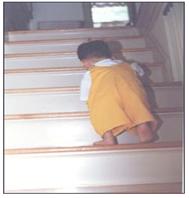
사진 3-121. 혼자서 계단위로 기어 올라갈 수 있다.
Copyright ⓒ 2012 John Sangwon Lee, MD., FAAP
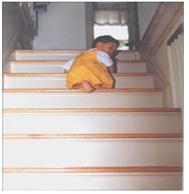
사진 3-122. 혼자서 계단위로 기어 올라갈 수 있다.
Copyright ⓒ 2012 John Sangwon Lee, MD., FAAP
2. 생후 12∼15개월 유아들의 손 발육
- 빈 컵 속이나 통 속에 손가락이나 손을 넣고 놀기를 좋아하기도 하고, 큰 물건 속에 더 작은 물건이나 장난감을 집어넣고 놀 수 있다.
- 신발 끈을 풀 수 있고
- 자기 혼자서 얼굴을 씻을 수 있고,
- 공을 던지면서 혼자 놀 수 있고
- 자신이 손가락으로 음식물을 집어 먹을 수 있다.
3. 생후 12∼15개월 유아들의 언어 발육
- ‘엄마’, ‘빠이빠이’, ‘아니’ 와 그 외 다른 단어 몇 개를 써서 말할 수 있다.
- 새로운 단어를 가르치면 따라서 배우기도 한다.
- 자기가 필요한 것이 있으면 필요한 것을 손으로 가리키면서 달라고 요구하기도 한다.
- 간단한 심부름도 할 수 있다.
4. 생후 12∼15개월 유아들의 사회성 발육
- 1~2세 이후부터 대부분의 유아들은 전보다 부모에게 점점 덜 의존적이다.
- 자기들이 부모들로부터 독립된 줄로 알고 있다.
- 그래서 자기들이 하고 싶은 대로 무엇이든지 혼자 하려고 고집을 부리는 유아들도 많다.
- 그들 자신이 무엇을 하려고 할 때 하지 말라고 하거나 ‘아니’라고 해도 자기들의 고집대로 계속 하려고 떼쓰고 부모의 간청이나 명령에 잘 따르지 않는 유아들도 많다.
- 그와 함께 놀아주고 그가 잘한 것에 대해 아끼지 말고 칭찬해 주면 아주 좋아한다.
- 어리광을 부리기도 하고 부모와 주위 사람들을 때로는 웃기기도 하고 귀엽게 행동하고 질투심이 많고 때로는 동정심도 많다.
- 경우에 따라 화를 내기도 한다.
- 어디에 무엇을 두었다가 혼자서 그것을 찾아 가지고 놀기도 한다.
- 자기가 갖고 놀고 싶은 것을 달라고 졸라대기도 한다.
- 장난감을 가지고 놀다가 부수기도 한다.
- 이 시기의 유아들은 무엇이든 잘 부수고 집어던지고 놀 수 있다.
- 안전사고가 날 위험성 있는 것들이나 귀중품 등은 그들의 손에 닿지 않는 곳에 잘 보관해야 한다.
- 음악 리듬에 맞춰 춤을 추기도 한다.
- 연필이나 크레용으로 종이에 선을 그릴 수 있다.
- 재미있는 그림책을 혼자서 보기도 한다.
- 15개월 경, 일부 유아들은 제가 싼 대소변으로 기저귀가 젖으면 기저귀가 젖었다는 것을 표현하고 방구석 어디에 오줌을 싼 후 자기가 오줌을 싼 것을 부모에게 알리기도 한다.
- 소변이나 대변을 보고 싶다고 ‘응가’ 또는 ‘피’ 등의 말로 표현하는 유아들도 있다.
- 이런 때부터 대소변 가리기 훈련을 서서히 시작할 수 있다.
- 그러나 강제로 대 소변가리기 훈련을 시키면 절대로 안 된다(대소변 가리는 훈련, “생후 1개월~6세의 영유아들의 발육 이정표” 참조).
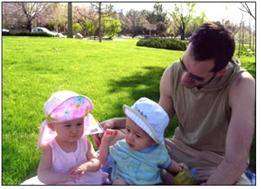
사진 3-123. 어린 자녀와 시간을 많이 보내면서 집중적 관심적 사랑을 해준다.
Copyright ⓒ 2012 John Sangwon Lee, MD., FAAP
| 생후 12∼15개월 유아들의 장난 |
장난감 참조
| 생후 12∼15개월 유아들의 영양 |
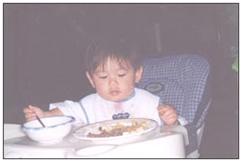
사진 3-125. 15개월 된 유아가 혼자서 국물도 먹고 손으로 수저로 음식물을 먹는다.
Copyright ⓒ 2012 John Sangwon Lee, MD., FAAP

사진 3-124. 15개월 된 유아가 혼자서 수저질을 하고 음식물을 식구들과 같이 먹는다.
Copyright ⓒ 2012 John Sangwon Lee, MD., FAAP

사진 3-126. 15개월 된 유아가 음식물을 손으로 먹는다. 부모가 음식물을 전적으로 떠 먹여서는 안 된다.
Copyright ⓒ 2012 John Sangwon Lee, MD., FAAP
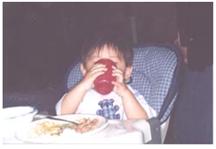
사진 3-127. 15개월 된 유아가 액체 음식물을 자신이 컵으로 마신다. 부모가 음식물을 전적으로 떠 먹여서는 안 된다.
Copyright ⓒ 2012 John Sangwon Lee, MD., FAAP
- 부모가 집에서 손수 요리한 이유식과 집안 식구들이 먹는 밥상 음식물을 주식으로 하루 3번 먹도록 한다.
- 주식과 주식 사이에 간식을 하루 2번 정도 준다.
- 아기가 좋아하는 음식물을 간식으로 준다.
- 이때부터 인공영양을 더 이상 먹일 필요가 없다.
- 주스, 인공영양, 전 우유 등 유동 음식물을 우유병에 넣어 아무 때나 빨아먹거나, 그런 음식물이 든 우유병을 빨게 하면서 유아들을 잠재우면 유치 충치가 생기기 쉽다.
- 전 우유나 주스 등 액체 음식물이 기도 속으로 흡인되어 들어가면 사레가 들릴 수 있고, 이관 속으로 들어가 중이염에 걸릴 수 있다.
- 유아가 유동 음식물을 우유병으로 빨아먹으면서 잠자지 않게 한다.
- 첫 돌이 지난 이후 모유수유를 계속 하고 싶으면 주로 낮에 3번 정도 모유 수유를 할 수 있다.
- 유아기 체중 증가 속도가 이전보다 정상적으로 느리다.
- 이 시기 유아들의 체중은 눈에 띄지 않게 서서히 조금씩 증가되는 것이 보통이다.
- 유아기 때부터 사춘기가 시작되기 바로 전까지 대부분의 유아들과 학령기 아이들은 음식물을 조금씩 먹는 것이 보통이다.
- 정상적으로 어떤 날은 거의 안 먹는 것 같고, 아침과 점심은 거의 먹지 않고 저녁만 많이 먹는가 하면, 그와 반대로 아침 식사에서 많이 먹고 점심 저녁 식사는 통 먹지 않는 식으로 먹는 유아들도 있다.
- 하루 종일 간식만 하고 주식은 통 먹지 않고, 며칠 동안 아주 잘 먹다가 다음 며칠 동안 통 안 먹는 식으로 음식물 섭취하는 유아들도 더러 있다.
- 부모는 유아기 자녀의 평소 식성과 입맛이 어떤지 파악하고 각 유아 자녀의 고유 음식물 섭취 패턴을 아는 것이 중요하다.
- 될 수 있는 한 유아가 좋아하는 음식물을 선택해서 균형 있게 영양분을 섭취하게 한다.
- 어떤 유아가 먹기 좋아하는 음식물을 골라 얼마동안 먹이다보면 대체로 탄수화물, 지방, 단백질, 야채류, 비타민, 물, 미네랄 등이 골고루 들어 있는 균형 잡힌 영양가 있는 음식물을 매일 섭취하고 있는 것을 알 수 있다.
- 아무 병도 없이, 때로는 1세경부터 4~5세까지, 혹은 사춘기가 시작하기 바로 전까지 마치 새가 모이 먹듯이 음식물을 조금씩 먹는 유아들도 있고 학령기 아이들도 더러 있다.
- 그들은 먹는 음식물 섭취패턴에 따라 서서히 성장된다.
- 이런 음식물 섭취 패턴 때문에 어떤 부모들은 ‘저 애는 하루 종일 아무 것도 먹지 않는다.’고 호소하면서 소아청소년과로 진료 받으러 데리고 온다.
- 전술한 바와 같이 이 시기의 대부분의 유아들의 체중 증가 속도가 정상적으로 느리다.
- 그 느린 성장 속도에 맞춰 음식물의 종류와 양을 섭취하기 때문에 부모들에게는 이 시기에 있는 유아 자녀들은 조금 먹는 것으로 나타난다.
- 그러나 식욕이 보통 때보다 현저히 떨어지고 어디가 아픈 것 같고 이상하면 소아청소년과에서 진찰 받도록 한다. [부모도 반의사가 되어야 한다-소아가정간호백과]-제 14권 소아청소년 내분비, 유전, 대사, 희귀병-음식물을 잘 먹지 않는 아이 참조.
| 생후 12∼15개월 유아들의 양호 |
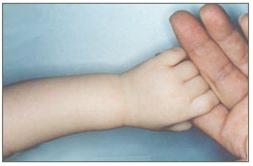
사진 3-128. 엄마! 나를 사랑하시나요.
Mom! Do you love me?
Copyright ⓒ 2012 John Sangwon Lee, MD., FAAP
- 1세 유아들의 대부분은 밤에 평균 9~10시간 정도 잔다.
- 1~3시간 정도 낮잠 자는 것이 보통이다.
- 첫 돌이 지난 유아들의 대부분은 육체적으로 대단히 활동적이고 어떤 유아들은 세상만사에 재미가 붙어 잠깐도 가만히 있지 않는다.
- 집안에서는 물론이고 집밖에서 일어나는 모든 일에 흥미를 진지하게 갖는다.
- 그 때문에 눈 한 번 깜짝할 사이에 부모도 모르게 길가에 혼자 나갈 수 있고 교통사고 등 안전사고가 나기 쉬우므로 안전사고에 각별히 주의 예방해야 한다.
- 방이나 부엌에서 서랍을 열고 그 안에 있는 것은 모든 것을 끄집어내고 놀기도 한다.
- 쓰레기통 등을 뒤지고 엎고 놀 수 있다.
- 약물이나 청소용 화학물질 등을 유아들의 손에 닿지 않는 곳에 잘 보관해야 한다.
- 뜨거운 다리미, 국물, 커피, 또는 목욕탕 물에 데지 않도록 각별히 조심해야 한다.
- 입 안에 넣을 수 없고, 삼키기 어렵고, 상처 낼 염려가 없고, 날카롭고 뾰족하지 않고 단단한 장난감을 사준다.
- 대소변 가리는 훈련을 시작한다.
- 대소변을 볼 시간이 되지 않을 때 강제로 배변 훈련을 시켜서는 안 된다.
- 편안히 앉아서 대소변을 쉽게 볼 수 있는 영유아용 변기를 이용해 대소변 가리기 훈련을 시킨다.
- 싸지 않고 배변 훈련용 변기에 대소변을 보면 잘 했다고 칭찬을 해 준다.
- 생후 12~15개월에 정기 건강검진을 받고 1차 홍역, 볼거리, 풍진(MMR) 백신 예방접종을 받는다.
- 생후 12~15개월에 1차 수두백신 예방접종을 받는다.
- 4차 DTaP는 생후 15~18개월에 접종 받는다.
- 전에 3차 IPV 백신 접종을 받지 안했으면 3차 불활성 소아마비 백신 예방접종(IPV)을 생후 6~18개월에 접종 받는다.
- 3차 B형 간염(HepB)예방접종을 생후 6~18개월에 접종 받는다.
- 히브(Hib)예방접종의 종류에 따라 다르지만, 4차 히브(Hib)예방접종을 12~15개월에 접종받고, 4차 폐렴 연쇄상구균에 의한 전염병백신 예방접종(PCV)을 12~15개월에 접종 받고 인플루엔자(Influenza) 백신 예방접종은 생후 6개월부터 매년마다 접종 받는다.
- 2차 A형 간염(HepA)백신 예방접종을 생후 12~23개월에 접종 받는다.
- 예방 접종의 횟수, 간격은 예방접종백신의 종류에 따라 다르고, 접종받는 해, 각 나라의 예방접종 권장 스케줄에 따라 다르다. 단골 소아청소년과나 사는 곳의 보건 당국에 문의해 접종하는 것이 원칙이다.
- ProQuad 백신이나 Pediarix 백신 등 종합 예방접종 백신으로 권장에 따라 접종한다.
- “Menhibrix 백신(2012년 6월)-미 FDA Neisseria meningitidis 혈청형 C, Y와 Haemophilus influenzae type b (Hib) 로 생기는 패혈증과 뇌수막염을 예방 할 수 있는 종합 백신이다. 생후 2, 4, 6개월과 12 ~15 개월에 총 4화 접종받을 수 있고 최초 접종은 생후 6주에 접종 받을 수 있다. 출처 Physician’s First Watch for June 15, 2012
- 다음 정기 건강검진은 생후 18개월경에 받는다.

사진 3-129. 정기 건강검진을 적기에 해 준다. 예방접종을 적기에 해준다. 한량을 들여 예방해 주는 것이 한근 들여 치료하는 것보다 훨씬 낫다. 저자와 검진 받는 유아.
Copyright ⓒ 2012 John Sangwon Lee, MD., FAAP
Growth and development of 12-15-month-old toddlers
Growth of 12-15 months old infants
Table 3-20. Percentiles of weight and height of 12-month-old Korean infants percentile
표 3-20. 12개월 된 한국 유아들의 체중과 신장의 백분위수
|
percentile
Gender |
3 | 10 | 25 | 50 | 75 | 90 | 97 | |
| Boy | weight(kg) | 7.35 | 8.10 | 8.70 | 9.45 | 10.12 | 11.00 | 12.40 |
| height(cm) | 68.0 | 70.7 | 73.2 | 75.5 | 78.1 | 82.0 | 87.0 | |
| girl | weight(kg) | 7.10 | 7.70 | 8.20 | 9.00 | 9.69 | 10.48 | 12.37 |
| height(cm) | 67.3 | 70.1 | 72.5 | 74.7 | 77.0 | 79.0 | 81.0 |

Figure 3-118. Growth charts and percentiles of Korean male newborns and male infants aged 0 to 36 months of age. Copyright ⓒ 2012 John Sangwon Lee, MD., FAAP

Figure 3-119. Korean newborn baby girl aged 0-36 months Growth charts and percentiles of young children and young women. Copyright ⓒ 2012 John Sangwon Lee, MD., FAAP
• Children from 12 months of age to children of 6 years old are called toddlers and preschool children.
• Infants aged 1 to 3 are called Toddlers, and the period of 4, 5, and 6 is called preschool children.
• In the United States, the term “toddler” is used a lot, but here it refers to children aged 1, 2, and 3 years.
• Measure the weight and height and draw them on the weight and height percentiles of the growth chart.
• Then check what percentile of their weight and height are belong to the growth chart.
• Check whether their weight and height are growing normally while continuing to increase approximately the same as before along the growth chart weight and height percentiles.
• It is common for 1-year-old toddlers to weigh three times their birth weight. Babies before entering kindergarten are usually significantly more physically active than they were before and have a great deal of interest and interest in what others have and everything around them other than their own.
• They like to play and are usually reluctant to sit still.
• Most of the infants before the age of 1 year old ate mostly from their parents’ service, but from then on, they try to decide and control the type, amount, and even the time they eat themselves.
• Even if parents give nutritious food that is delicious and best for the health of children, toddlers may not eat well.
• It is common for them to choose only foods that fit their tastes. It is normal for toddlers to gain weight significantly slower than infants of 6 to 9 months of age until their first birthday.
• Weight gain is normally fairly slow from the first birthday until some time before puberty begins.
• Some toddlers and preschoolers, normally grow very slowly, so many parents worry that they will not grow well.

Picture 3-120. 1-year-old infant. He can walk well on my own. Copyright ⓒ 2012 John Sangwon Lee, MD., FAAP
Development of toddlers 12 to 15 months of age
1. Physical development of 12-15 months old toddlers
• Most children at this age can crawl from room to room, and some can toddle around.
• Most children at this age like to play while sitting on their mother’s or father’s lap.
• Can hold Mom and Dad’s hand and walk down her stairs, and climb upstairs by herself (Pictures 3-121, 3-122).
• Toddlers can play the prank of pouring sand into an empty toy box.
• Toddlers at this age are prone to various safety accidents by walking alone from one room to another in the blink of an eye.
• Special precautions must be taken to avoid accidents.

Picture 3-121. You can climb the stairs by yourself. Copyright ⓒ 2012 John Sangwon Lee, MD., FAAP

Picture 3-122. You can climb the stairs by yourself. Copyright ⓒ 2012 John Sangwon Lee, MD., FAAP
2. Hand development of 12-15 months old Toddlers
• Likes to play with fingers or hands in empty cups or buckets, and may play with smaller objects or toys in larger objects.
• Toddlers can untie their shoelaces and
• Be able to wash your face by yourself,
• Can play alone while throwing the ball
• Toddlers can pick up food with your fingers.
3. Language development of 12-15 months old Toddlers
• Can speak using ‘Mom’, ‘Pai Pai’, ‘No’, and a few other words.
• When you teach a new word, toddlers learn it accordingly.
• If Toddlers need something, point to what toddlers need and ask for it.
• Can do simple errands.
4. Social development of 12-15-month-old toddlers
• From 1 to 2 years of age, most toddlers become less and less dependent on their parents than before.
• They know they are independent of their parents
• So many toddlers are stubborn to do whatever they want on their own.
• There are many toddlers who do not obey their parents’ pleas or orders when they themselves tell them not to do it, or even if they say ‘no’, they try to stick with their stubbornness.
• They like it when parents play with them and praise them for what they do well.
• Be foolish, sometimes funny, cute, jealous, and sympathetic to parents and people around them.
• Sometimes I get angry.
• Toddlers put something somewhere, find it by themselves, and play with it.
• They even insist on something they want to play with.
• Sometimes they break toys while playing with them.
• Toddlers at this age can crush, throw, and play with anything.
• Things that are at risk of safety accidents or valuables should be kept out of their reach.
• They dance to the rhythm of the music.
• Toddlers can draw lines on paper with a pencil or crayon.
• Toddlers can also read interesting picture books by themselves.
Around 15 months of age, some toddlers express that their diaper is wet when they get wet with cheap feces and pee in the corner of the room, and then inform their parents that they have peed.
• Some toddlers express their desire to urinate or defecate with words such as ‘poop’ or ‘blood’.
• From this point on, you can start training to cover the bowels gradually.
• However, you should never force urination or urination training (see urination and urination training, “Milestones in the development of infants and toddlers 1 month to 6 years of age”).

Picture 3-123. They spend a lot of time with their young children, giving them intensive attention and love. Copyright ⓒ 2012 John Sangwon Lee, MD., FAAP
Pranks for children aged 12-15 months
Toy reference
Nutrition for 12-15 months old infants

Picture 3-125. A 15-month-old toddler eats soup alone and eats food with a spoon by hand. Copyright ⓒ 2012 John Sangwon Lee, MD., FAAP

Picture 3-124. A 15-month-old infant cooks alone and eats food with family members. Copyright ⓒ 2012 John Sangwon Lee, MD., FAAP

Picture 3-126. A 15-month-old infant eats food with his hands. Parents should not feed them entirely by scooping up food. Copyright ⓒ 2012 John Sangwon Lee, MD., FAAP

Picture 3-127. A 15-month-old infant drinks liquid food from his own cup. Parents should not feed them entirely by scooping up food. Copyright ⓒ 2012 John Sangwon Lee, MD., FAAP
• Make sure that toddlers eat baby food prepared by their parents at home and food from your family’s table 3 times a day.
• Give snacks twice a day between stocks.
• Treat your baby’s favorite food as a snack.
• From this point on, artificial nutrition is no longer necessary.
• If liquid food such as juice, artificial nutrition, whole milk is put in a milk bottle and sucked at any time, or if toddlers are put to sleep while sucking a milk bottle containing such food, it is easy to cause tooth decay.
• If liquid food such as whole milk or juice can be aspirated into the airways, toddlers may be choked and they may get otitis media due to sucking foods into the middle ear cavity thru the Eustachian tube.
• Do not allow infants to fall asleep while sucking liquid food from the bottle.
• If you want to continue breastfeeding after your first birthday, you can usually breastfeed 3 times a day.
• toddlers’ weight gain is normally slower than before.
• It is common for toddlers at this age to gradually gain weight little by little without notice.
• From toddlers to just before the onset of puberty, it is common for most toddlers and school-aged children to eat small portions.
• Normally, on some days, it seems that they rarely eat, and they eat little breakfast and lunch and only a lot of dinner. Conversely, there are toddlers who eat a lot at breakfast and not a whole lunch and dinner.
• Some toddlers eat only snacks all day and no whole staple food, eating very well for a few days and then not eating a whole lot for the next few days.
• It is important for parents to know what their toddler’s eating habits and tastes are like and to know each toddler’s unique food intake patterns.
• As far as possible, make sure your toddlers choose their favorite foods and get a balanced diet.
• If a toddler chooses a favorite food and feeds it for a while, it can be seen that in general, he eats a balanced and nutritious food containing carbohydrates, fats, proteins, vegetables, vitamins, water, and minerals every day.
• Some toddlers and other preschool-age children eat little by little like a bird feeds without any illness, sometimes from around the age of 1 to 4 or 5 years of age, or just before the onset of puberty.
• They grow slowly according to the food intake patterns they eat.
• Because of this eating pattern, some parents bring them to the pediatric clinic, complaining that ‘the child doesn’t eat anything all day.’
• As mentioned above, most toddlers and preschoolers this age gain weight normally slowly.
• It appears to parents that toddlers and preschoolers children at this age eat little because they consume the type and amount of food according to their slow growth rate.
• However, if your appetite is significantly lower than usual and if you feel sick or strange, see a pediatrician. www.drleepediatrics.com-Volume 14 Children and adolescents Endocrine, heredity, metabolism, and rare diseases-Refer to children who do not eat well.
Parenting for toddlers children aged 12-15 months

Picture 3-128. Mom! do you love me, Mom! Do you love me? Copyright ⓒ 2012 John Sangwon Lee, MD., FAAP
• Most 1-year-olds sleep an average of 9 to 10 hours per night.
• It is normal to take a nap of 1 to 3 hours.
• Most of the first-year-old children are very physically active, and some are so excited about the world that they do not sit still for a moment.
• Take a serious interest in everything that happens both inside and outside the home.
• Therefore, in the blink of an eye, they can go out on the road alone without their parents knowing, and safety accidents such as traffic accidents are easy to occur.
• Open a drawer in a room or kitchen and pull out everything in it and play with it.
• Toddlers can rummage through trash cans and play.
• Keep medications and cleaning chemicals out of reach of toddlers’ children.
• Be very careful not to burn themself with a hot iron, broth, coffee, or bathwater.
• Buy toys that are hard to put in their mouth, that is difficult to swallow, that is not likely to hurt you, and that is sharp, non-pointy, and hard.
• Begin cover-up training.
• Do not force potty training when you do not have time to urinate.
• Use the toilet for toddlers to sit comfortably and pass urine easily.
• If toddlers urinate in a toilet without wetting, praise them for doing well.
• At 12 to 15 months of age, receive regular health check-ups and primary measles, mumps and rubella (MMR) vaccinations.
• Get the primary chickenpox vaccine at 12-15 months of age.
• The fourth dose of DTaP is given at 15-18 months of age.
• Receive a third dose of inactive polio vaccine (IPV) at 6 to 18 months of age if not previously vaccinated against 3rd IPV.
• The third hepatitis B (HepB) vaccination is given at 6-18 months of age.
• Depending on the type of Hib vaccination, the 4th Hib vaccination is received at 12-15 months, and the 4th Pneumococcal Streptococcus Vaccine (PCV) is administered at 12-15 months. Influenza vaccine is given every year from 6 months of age
• Receive the second hepatitis A (HepA) vaccine at 12 to 23 months of age.
• The frequency and interval of vaccination differ depending on the type of vaccination, the year of vaccination, and the recommended vaccination schedule in each country. In principle, you should inquire at your regular pediatrician or the health authorities of the place you live to get vaccinated.
• Inoculate as recommended with a combined vaccine such as the ProQuad vaccine or Pediarix vaccine.
• “Menhibrix Vaccine (June 2012) – A combined vaccine that can prevent sepsis and meningitis caused by Neisseria meningitidis serotypes C and Y and Haemophilus influenzae type b (Hib) by the US FDA. A total of 4 doses can be given at 12-15 months of age, and the first dose can be given at 6 weeks of age Source Physician’s First Watch for June 15, 2012
• The next regular health checkup will be received around 18 months of age.

Picture 3-129. Periodic health check-ups are conducted in a timely manner. Vaccinations are given in a timely manner. It is much better to spend a single dose to prevent it than to treat it with a single dose. The author examined toddlers. Copyright ⓒ 2012 John Sangwon Lee, MD., FAAP
출처 및 참조문헌
- Nelson Textbook of Pediatrics 22ND Ed
- The Harriet Lane Handbook 22ND Ed
- Growth and development of the children
- www.drleepediatrics.com 제1권 소아청소년 응급 의료
- www.drleepediatrics.com 제2권 소아청소년 예방
- www.drleepediatrics.com 제3권 소아청소년 성장 발육 육아
- www.drleepediatrics.com 제4권 모유,모유수유, 이유
- www.drleepediatrics.com 제5권 인공영양, 우유, 이유식, 비타민, 미네랄, 단백질, 탄수화물, 지방
- www.drleepediatrics.com 제6권 신생아 성장 발육 육아 질병
- www.drleepediatrics.com제7권 소아청소년 감염병
- www.drleepediatrics.com제8권 소아청소년 호흡기 질환
- www.drleepediatrics.com제9권 소아청소년 소화기 질환
- www.drleepediatrics.com제10권. 소아청소년 신장 비뇨 생식기 질환
- www.drleepediatrics.com제11권. 소아청소년 심장 혈관계 질환
- www.drleepediatrics.com제12권. 소아청소년 신경 정신 질환, 행동 수면 문제
- www.drleepediatrics.com제13권. 소아청소년 혈액, 림프, 종양 질환
- www.drleepediatrics.com제14권. 소아청소년 내분비, 유전, 염색체, 대사, 희귀병
- www.drleepediatrics.com제15권. 소아청소년 알레르기, 자가 면역질환
- www.drleepediatrics.com제16권. 소아청소년 정형외과 질환
- www.drleepediatrics.com제17권. 소아청소년 피부 질환
- www.drleepediatrics.com제18권. 소아청소년 이비인후(귀 코 인두 후두) 질환
- www.drleepediatrics.com제19권. 소아청소년 안과 (눈)질환
- www.drleepediatrics.com 제20권 소아청소년 이 (치아)질환
- www.drleepediatrics.com 제21권 소아청소년 가정 학교 간호
- www.drleepediatrics.com 제22권 아들 딸 이렇게 사랑해 키우세요
- www.drleepediatrics.com 제23권 사춘기 아이들의 성장 발육 질병
- www.drleepediatrics.com 제24권 소아청소년 성교육
- www.drleepediatrics.com 제25권 임신, 분만, 출산, 신생아 돌보기
- Red book 29th-31st edition 2021
- Nelson Text Book of Pediatrics 19th- 21st Edition
- The Johns Hopkins Hospital, The Harriet Lane Handbook, 22nd edition
- 응급환자관리 정담미디어
-
소아가정간호백과–부모도 반의사가 되어야 한다, 이상원
-
Neonatal Resuscitation American heart Association
-
Neonatology Jeffrey J.Pomerance, C. Joan Richardson
-
Pediatric Resuscitation Pediatric Clinics of North America, Stephen M. Schexnayder, M.D.
-
Pediatric Critical Care, Pediatric Clinics of North America, James P. Orlowski, M.D.
-
Preparation for Birth. Beverly Savage and Dianna Smith
-
Infectious disease of children, Saul Krugman, Samuel L Katz, Ann A. Gershon, Catherine Wilfert
- 소아과학 대한교과서
- Growth and Development of Children, Eighth Edition, George H. Lowrey, Yearbook Medical Publishers
- Growth and Development of Children, Fifth Edition, E. H. Watson and G. H. Lowrey, Yearbook Medical Publishers
- Other
|
Copyright ⓒ 2015 John Sangwon Lee, MD., FAAP 미국 소아과 전문의, 한국 소아청소년과 전문의 이상원 저 “부모도 반의사가 되어야 한다”-내용은 여러분들의 의사로부터 얻은 정보와 진료를 대신할 수 없습니다. “The information contained in this publication should not be used as a substitute for the medical care and advice of your doctor. There may be variations in treatment that your doctor may recommend based on individual facts and circumstances. “Parental education is the best medicine.” |